Research
Findings #14: Health Insurance Status of the Civilian Noninstitutionalized
Population, 1999
by Jeffrey A. Rhoades, Ph.D., and May C. Chu,
B.A., Agency for Healthcare Research and Quality
Abstract
This report from the 1999 Medical Expenditure Panel Survey (MEPS) provides preliminary estimates of the health insurance status of the civilian noninstitutionalized U.S. population during the first half of 1999, including the size and characteristics of the population with private health insurance, with public insurance only, and without any health care coverage. During this period, 84.2 percent of all Americans were covered by private or public health insurance, leaving 15.8 percent of the population, some 42.8 million people, uninsured. Among the non-elderly population, 82.1 percent of Americans had either private or public coverage only and 17.9 percent of the population (42.6 million people) lacked health care coverage. Among the elderly population, there was a significant drop from 1998 to 1999 in private health insurance coverage and a corresponding significant increase in coverage by public health insurance only. The probability that an individual would be uninsured during this period was especially high for young adults ages 19–24 and members of racial and ethnic minorities (especially Hispanics). Public health insurance continues to play an important role in ensuring that children, black Americans, and Hispanic Americans obtain health care coverage.
Introduction
This report is the fourth in a series
of reports on the health insurance status of the U.S. population.
Previous reports have presented health insurance estimates
for the first part of 1996 (Vistnes and Monheit, 1997), 1997
(Vistnes and Zuvekas, 1999), and 1998 (Rhoades, Brown and
Vistnes, 2000).
The health insurance status of the U.S.
population, especially the size and composition of the uninsured
population, has become an issue of perennial public policy
concern for several reasons. First, health insurance is viewed
as essential to ensure that individuals obtain timely access
to medical care and protection against the risk of expensive
and unanticipated medical events. Compared to people without
health care coverage, insured individuals are more likely
to have a usual source of medical care, to spend less out
of pocket on health services, and to experience different
treatment patterns, quality, and continuity in their health
care (Lefkowitz and Monheit, 1991; U.S. Congress, Office of
Technology Assessment, 1992).
Second, concern over the population's
health insurance status reflects a variety of equity and efficiency
considerations. These include the magnitude and appropriate
mix of private and public sector responsibility for financing
health care, the impact of health insurance on the efficient
use of health care, and the manner in which health insurance
affects the distribution of health care among the general
population and across groups of specific policy interest.
Third, timely and reliable estimates of
the population's health insurance status are essential to
evaluate the costs and expected impact of public policy interventions
to expand coverage or to alter the manner in which private
and public insurance is financed. Identification of how individual
and household demographic characteristics, health status,
and economic circumstances are associated with the population's
health insurance status is of critical importance in developing
efficient and targeted policy interventions. This is especially
relevant given the current emphasis on incremental health
care reform that is focused on particular health care markets
and population groups.
Finally, comparisons
of the characteristics of insured and uninsured populations
over time provide information
on whether greater equity has been achieved in the ability
of specific population groups to obtain health insurance or
whether serious gaps remain. In this regard, estimates of
the population's health insurance status from the Medical
Expenditure Panel Survey (MEPS), which is conducted annually,
provide critical data for evaluating the health insurance
implications of recent legislative initiatives: the 1996 Health
Insurance Portability and Accountability Act (HIPAA), Public
Law 104–191; welfare reform under the 1996 Personal Responsibility
and Work Opportunity Reconciliation Act, Public Law 104–193;
and the 1997 State Children's Health Insurance Program (SCHIP).
A primary goal of HIPAA is to reduce the impact of preexisting
health conditions on the continuity of health insurance during
employment transitions. Under welfare reform, mandated work
requirements and time limitations governing the receipt of
public assistance may have consequences for a recipient's
health insurance status. The goal of the SCHIP program is
to provide health insurance coverage to low-income children
who are not eligible for Medicaid.
This report presents preliminary estimates
of the number and characteristics of people with private and
public health insurance at any time during the first half
of 1999, on average. Particular emphasis is directed toward
estimating the size of the population that was uninsured throughout
the first half of 1999 and identifying groups especially at
risk of lacking health insurance.
^top
Overview
During the first half of 1999, on average,
84.2 percent of all Americans in the civilian noninstitutionalized
population had some type of private or public health insurance
coverage (Table 1). About 68
percent of Americans obtained health insurance from private
sources. Another 16.1 percent had only public sources of coverage,
primarily Medicare and Medicaid. (Throughout this report,
the public health insurance category includes only people
who had no coverage except public health insurance.) The remaining
15.8 percent of Americans, 42.8 million people, were without
health insurance throughout the first half of 1999. Among
the non-elderly population, 70.4 percent were covered by private
insurance and 11.7 percent by public insurance. Among the
non-elderly population, an estimated 42.6 million individuals
(17.9 percent) were uninsured. Table
2 gives more detailed information on the health insurance
status of the non-elderly population.
Overall these health insurance estimates
do not differ significantly from the 1998 MEPS figures for
the non-elderly population, as reported in Rhoades, Brown,
and Vistnes (2000). However, there were differences between
the two years for the elderly population. These differences
are discussed below.
Tables
1-3 provide
estimates of the population's health insurance status according
to selected demographic characteristics, perceived health
status, employment status, and residential location. Table
4 provides estimates of the distribution of the uninsured
population by selected characteristics. Table
A in the technical appendix provides
estimates of the number of people by health insurance status.
Some of the key findings and relationships revealed by these
data are discussed below.
Age
MEPS data reveal that, in general, children
are more likely than non-elderly adults to have health insurance
coverage. The main findings among age groups are described
below.
Children
There has been considerable interest in
the health insurance status of children. This interest stems
from the role health care coverage plays in ensuring that
children obtain the medical care appropriate to their specific
stage of development. To help ensure such coverage, Congress
passed the State Children's Health Insurance Program in 1997,
allocating approximately $24 billion over 5 years to provide
health insurance coverage to low-income children who are not
eligible for Medicaid. The SCHIP program follows on Medicaid
expansions beginning in the late 1980s that focused attention
on the role of the public and private sectors in financing
health care for low-income children.
MEPS data indicate
that public health insurance covered a substantial proportion
of children in
the first half of 1999: 28.1 percent of children under age
4, one in four children ages 4–6 (24.0), and one in five
children ages 7–12 (19.2) had public coverage, primarily
through Medicaid. As a result, the proportion uninsured among
children under age 18 (13.6 percent) was lower than the proportion
among non-elderly adults in general (19.7 percent for ages
18–64). Despite this finding, about 9.8 million children
lacked health care coverage.
Adults
Young adults
ages 19–24 were the
age group most likely to lack health insurance. Nearly a third
of young adults (32.2 percent) were uninsured, twice the rate
at which all Americans lacked coverage.
Slightly more than half of elderly Americans
(50.8 percent) were covered by private health insurance. Slightly
less than half of elderly Americans (48.6 percent) held public
coverage only (Medicare alone or in conjunction with Medicaid).
These estimates differ significantly from estimates for 1998,
when 55.3 percent of the elderly were covered by private health
insurance and 43.8 percent were covered by public health insurance.
This continues a trend first observed between 1997 and 1998,
when the percent of the elderly covered by private health
insurance declined from 60.5 percent to 55.3 percent (Rhoades,
Brown, and Vistnes, 2000).
There are several possible reasons for
the observed drop in private health insurance coverage among
the elderly. Increases in Medicare health maintenance organization
enrollment may have prompted people to drop private health
insurance; people may have elected to drop Medigap health
insurance policies as premiums have risen; and former employers
may have opted to discontinue private health insurance coverage
for retirees or have become unable to provide such coverage.
However, there are currently insufficient data to determine
definitively why these changes have occurred over the 3-year
period.
Employment Status
Since most
private health insurance in the United States is provided
through the workplace, employment
status is an important indicator of access to private health
insurance. MEPS data reveal the following for the population
ages 16–64 (Table 2):
- Almost four-fifths (79.9 percent) of
workers were covered by private health insurance, compared
to half (51.2 percent) of individuals who were not employed.
- People who were not employed were more
likely than those who were employed to be covered by public
insurance (21.8 and 3.4 percent, respectively).
- Workers were less likely than people
who were not employed to be uninsured (16.8 and 27.0 percent,
respectively).
Race/Ethnicity
MEPS data indicate that significant disparities
exist in the rate at which racial and ethnic minorities are
covered by private and public health insurance compared to
white Americans (Table 1). For
example:
- Less than half of all Hispanic Americans
(45.5 percent) and slightly more than half of black Americans
(53.0 percent) were covered by private health insurance,
compared to three-quarters of whites (75.0 percent). Over
a third of Hispanics (34.2 percent) and almost a fifth of
blacks (19.2 percent) were uninsured. In contrast, 12.1
percent of white Americans were uninsured.
- Hispanic and black Americans were more
likely than white Americans to be covered by public health
insurance (20.3 percent and 27.8 percent, respectively,
compared to 12.9 percent for white Americans).
Marital Status
Widowed people were less likely to have
private health insurance coverage in 1999 (43.6 percent) than
in 1998 (50.7 percent) and more likely to have public insurance
only (49.6 percent and 43.1 percent, respectively) (Rhoades,
Brown, and Vistnes, 2000). These changes in health insurance
coverage for widowed people can be attributed to similar changes
observed among the elderly population, many of whom are widowed,
for the two years (data not shown). Among adults under age
65, married people were more likely to have private health
insurance (82.0 percent) and less likely to have public insurance
(4.7 percent) or be uninsured (13.3 percent) than unmarried
people were (Table 2). Of people
ages 16–64 who were not married at the time of the survey:
- Over one-quarter of widowed people were
uninsured (26.4 percent).
- Almost one-quarter of all divorced people
were uninsured (24.6 percent). The proportion of divorced
people covered by public insurance declined from 13.8 percent
in 1998 (Rhoades, Brown, and Vistnes, 2000) to 9.5 percent
in 1999.
- Almost one-third of Americans who were
separated were uninsured (32.8 percent).
- More than one-quarter of Americans who
never married were uninsured (26.8 percent).
Residential Location
The type of health care coverage obtained
by Americans and the likelihood of being uninsured also varied
by region and whether or not they lived in a metropolitan
statistical area (MSA). Table 1 shows
that:
- People living outside MSAs were less
likely than those living within MSAs to be covered by private
health insurance (64.5 percent vs. 68.9 percent).
- People living in the West were less likely
than residents of the Northeast and Midwest to have private
health insurance (62.6 percent in the West compared to 69.9
percent in the Northeast and 73.5 percent in the Midwest).
Nearly one out of five people in the West and South were
uninsured (18.9 percent and 17.5 percent, respectively),
compared to 12.8 percent in the Northeast and 12.7 percent
in the Midwest.
Health Status
There is considerable public policy interest
in determining whether people with health problems are able
to obtain health insurance and, if so, the source of such
coverage. MEPS respondents were asked to rate their health
and family members' health as excellent, very good, good,
fair, or poor. The data in Table
3 reveal the relationships described below between health
status and insurance coverage.
Non-Elderly People
More than one in five non-elderly Americans
in good health (21.4 percent) or fair health (20.9 percent)
were uninsured throughout the first half of 1999. Among the
non-elderly:
- People in fair or poor health were less
likely than those in better health to have private health
insurance. Only 42.2 percent of those in poor health and
54.8 percent of those in fair health had any private coverage.
- Public insurance helped to reduce the
health-related disparities in coverage. Almost one-quarter
(24.2 percent) of people in fair health and 4 in 10 (40.9
percent) of the people in poor health had public coverage.
Nevertheless, those in good or fair health were more likely
than people in very good or excellent health to be uninsured.
Elderly People
Elderly Americans in fair or poor health
were less likely to have private coverage than those in good
or better health. As a result, those in fair or poor health
were more likely to be covered by insurance from public sources
only (64.1 percent and 57.9 percent, respectively) than other
elderly Americans. Medicare, either alone or with Medicaid,
was the main public source of coverage. There were significant
differences between the 1999 and 1998 estimates for elderly
people in fair health: a significant decrease in the percent
covered by private health insurance (34.5 percent in 1999
vs. 49.0 percent in 1998) and a corresponding significant
increase in the percent covered by public health insurance
only (64.1 percent in 1999 vs. 50.7 percent in 1998). Presently
there are insufficient data to determine why these changes
have occurred between the two years.
^top
Characteristics of Uninsured Americans
Previous sections of this report have
described the health insurance status of Americans by focusing
on demographic, health status, and geographic characteristics
associated with the likelihood that particular groups obtained
private or public health insurance or were more at risk of
being uninsured. To put this discussion in perspective, data
displayed in Table 4 characterize
the uninsured population by considering the representation
of specific groups in the general population of non-elderly
Americans relative to their representation among the uninsured
population. In this way, one can assess whether certain population
groups are disproportionately represented among the uninsured.
Such information can be useful in formulating targeted policy
interventions on behalf of people without health insurance.
Age
Children under
the age of 18 comprised slightly less than one-quarter (23.0
percent) of the uninsured
population. Young adults ages 19–24 composed 8.4 percent
of the non-elderly population but 15.1 percent of the uninsured
population. Among all age groups, young adults had the greatest
risk of being uninsured.
For individuals
ages 30–34 and 55–64,
there was a significant change in the percent distribution
of the uninsured population between 1998 and 1999. The proportion
of the uninsured population represented by ages 30–34
declined from 10.0 percent in 1998 to 8.3 percent in 1999,
while the proportion ages 55–64 increased from 6.8 percent
in 1998 to 9.2 percent in 1999. These changes reflect a shift
in the age distribution of the population between 1998 and
1999 rather than a change in risk for being uninsured.
Sex
While males comprised slightly less than
half of the non-elderly population, they represented 53.4
percent of the uninsured population.
Race/Ethnicity
Racial and ethnic minorities were more
at risk of lacking health insurance than white Americans were.
As a result, minority representation among the uninsured exceeded
their representation among the general population. For example, Table
4 shows that:
- Hispanics represented only 12.6 percent
of all non-elderly Americans but 25.2 percent of the uninsured
population. Hispanics were the racial/ethnic group most
likely to be uninsured (35.9 percent).
- Although almost 7 out of 10 non-elderly
Americans were white (69.6 percent), whites accounted for
less than 6 out of 10 uninsured persons (54.6 percent).
- When the uninsured are categorized by
race/ethnicity and sex, white males and females represent
the largest proportions of the uninsured population: 28.9
and 25.7 percent, respectively.
^top
Conclusions
Preliminary estimates from the 1999 MEPS
reveal that, during the first half of 1999, 68.1 percent of
Americans obtained health insurance from private sources,
16.1 percent obtained coverage through public programs, and
15.8 percent of the population (42.8 million people) lacked
any health care coverage. Among the non-elderly population,
over one person in six was uninsured.
In general, there was no difference between
the 1998 and 1999 estimates for the non-elderly population.
However, among the elderly population there was a significant
drop in the rate of private health insurance coverage and
a corresponding significant increase in public health insurance
coverage only, a trend that continues from 1997.
The tabulations
presented in this report indicate that the health insurance
status of the U.S. population
is strongly associated with specific demographic characteristics,
health status, and employment status. Important disparities
in health care coverage exist for particular groups. Among
the groups especially at risk of lacking health care coverage
are young adults ages 19–24 and members of racial and
ethnic minorities (especially Hispanic Americans). Public
health insurance continues to play an important role in insuring
children, black Americans, and Hispanic Americans. Disparities
in the proportion with insurance coverage also exist by health
status, with non-elderly people in good or fair health more
likely than people in better health to be uninsured.
^top
References
Cohen J, Monheit
A, Beauregard K, et al. The Medical Expenditure Panel Survey:
a national health information
resource. Inquiry 1996;33:373–89.
Cohen S. Sample
design of the 1996 Medical Expenditure Panel Survey Household
Component. Rockville (MD):
Agency for Health Care Policy and Research; 1997. MEPS Methodology
Report No. 2. AHCPR Pub. No. 97–0027.
Lefkowitz D,
Monheit A. Health insurance, use of health services, and
health care expenditures. Rockville
(MD): Agency for Health Care Policy and Research; 1991. National
Medical Expenditure Survey Research Findings 14. AHCPR Pub.
No. 92–0017.
Rhoades J,
Brown E, Vistnes J. Health insurance status of the civilian
noninstitutionalized population:
1998. Rockville (MD): Agency for Healthcare Research and Quality;
2000. MEPS Research Findings No. 11. AHRQ Pub. No. 00–0023.
U.S. Congress, Office of Technology Assessment.
Does health insurance make a difference? Background paper.
Washington: U.S. Government Printing Office; 1992. Report
No. OTA-BP-H-99.
Vistnes J,
Monheit A. Health insurance status of the civilian noninstitutionalized
population: 1996.
Rockville (MD): Agency for Health Care Policy and Research;
1997. MEPS Research Findings No. 1. AHCPR Pub. No. 97–0030.
Vistnes J,
Zuvekas S. Health insurance status of the civilian noninstitutionalized
population: 1997.
Rockville (MD): Agency for Health Care Policy and Research;
1999. MEPS Research Findings No. 8. AHCPR Pub. No. 99–0030.
^top
Tables
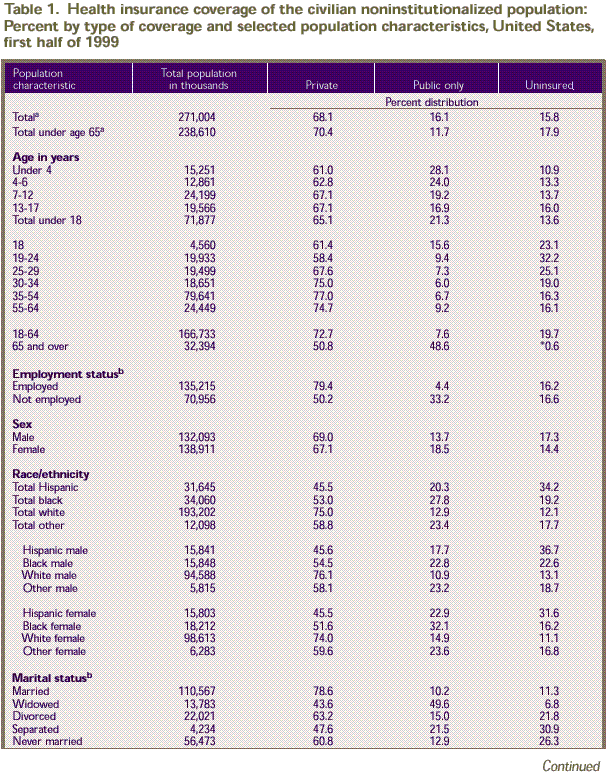
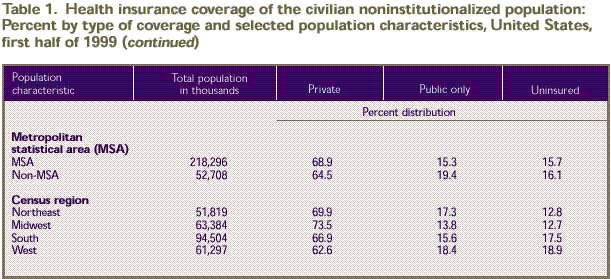
a Includes persons with unknown
employment status and marital status.
b For individuals age 16 and over.
* Relative standard error is greater than
or equal to 30 percent.
Note: Percents may not add to 100
because of rounding.
Source: Center for Financing, Access,
and Cost Trends, Agency for Healthcare Research and Quality:
Medical Expenditure Panel Survey Household Component, 1999.
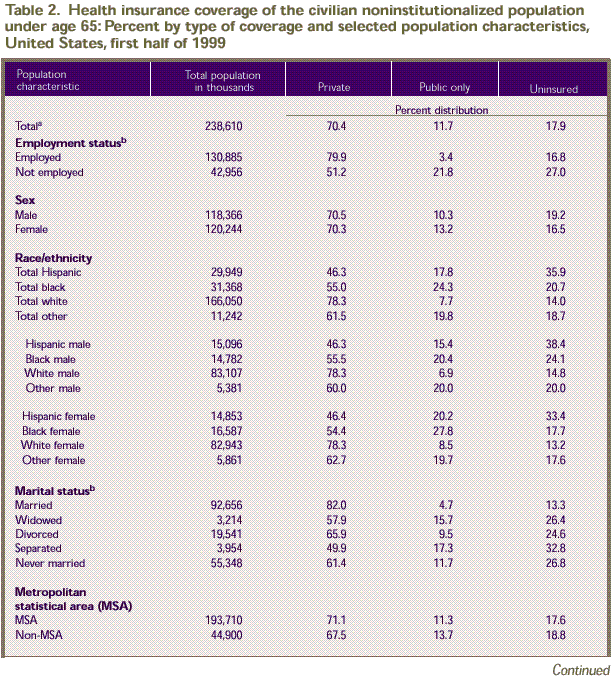
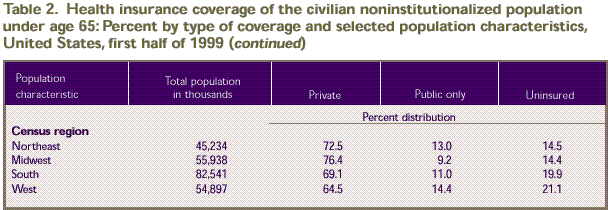
a Includes persons with unknown
employment status and marital status.
b For individuals age 16 and over.
Note: Percents may not add to 100
because of rounding.
Source: Center for Financing, Access,
and Cost Trends, Agency for Healthcare Research and Quality:
Medical Expenditure Panel Survey Household Component, 1999.
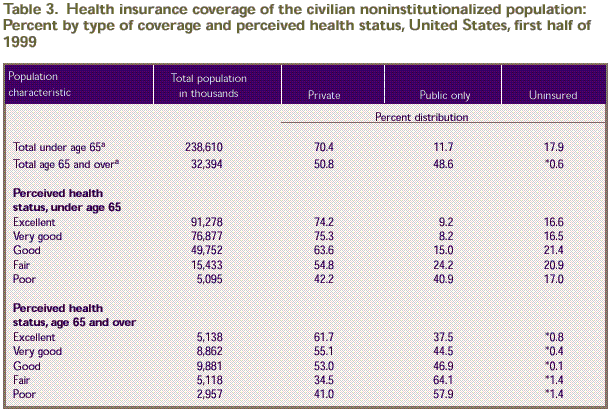
a Total includes persons with
unknown perceived health status.
* Relative standard error is greater than
or equal to 30 percent.
Note: Percents may not add to 100
because of rounding.
Source: Center for Financing, Access,
and Cost Trends, Agency for Healthcare Research and Quality:
Medical Expenditure Panel Survey Household Component, 1999.
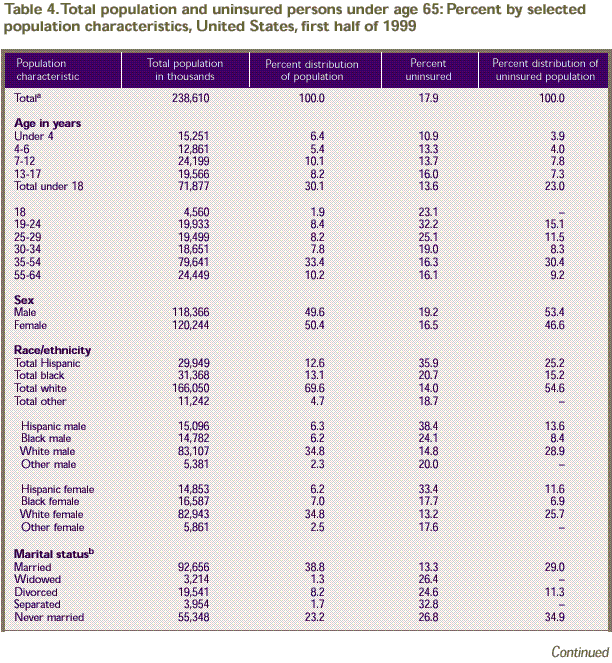

a Total
includes persons with unknown perceived health status and
marital status.
b For individuals age 16 and over. Excludes unknown
marital status. As a result, percents do not sum to 100.
- Sample
size too small to produce reliable estimates.
Note: Percent
distributions may not add to 100 because of rounding.
Source: Center
for Financing, Access, and Cost Trends, Agency for Healthcare
Research and Quality: Medical Expenditure Panel Survey Household
Component, 1999.
^top
Technical Appendix
This data in this report were obtained
in the first round of interviews for the Household Component
(HC) of the 1999 Medical Expenditure Panel Survey (MEPS).
MEPS is cosponsored by the Agency for Healthcare Research
and Quality (AHRQ) and the National Center for Health Statistics
(NCHS). The MEPS HC is a nationally representative survey
of the U.S. civilian noninstitutionalized population that
collects medical expenditure data at both the person and household
levels. The focus of the MEPS HC is to collect detailed data
on demographic characteristics, health conditions, health
status, use of medical care services, charges and payments,
access to care, satisfaction with care, health insurance coverage,
income, and employment. In other components of MEPS, data
are collected on the use, charges, and payments reported by
providers; residents of licensed or certified nursing homes;
and the supply side of the health insurance market.
The sample for the MEPS HC was selected
from respondents to the National Health Interview Survey (NHIS),
which was conducted by NCHS. NHIS provides a nationally representative
sample of the U.S. civilian noninstitutionalized population
and reflects an oversampling of Hispanics and blacks. The
MEPS HC collects data through an overlapping panel design.
In this design, data are collected through a precontact interview
that is followed by a series of five rounds of interviews
over 2 1/2 years. Two calendar years of medical expenditure
and utilization data are collected from each household and
captured using computer-assisted personal interviewing (CAPI).
This series of data collection rounds is launched again each
subsequent year on a new sample of households to provide overlapping
panels of survey data which, when combined with other ongoing
panels, will provide continuous and current estimates of health
care expenditures. The reference period for Round 1 of the
1999 MEPS HC (Panel 4) was from January 1, 1999, to the date
of the Round 1 interview. Interviews for Panel 4 (Round 1)
were conducted from March to July 1999.
Derivation of Insurance Status Information
The household respondent was asked if
during the interview period anyone in the family was covered
by any of the sources of public and private health insurance
coverage discussed in the following paragraphs. Coverage by
Medicare and TRICARE, formerly known as CHAMPUS/CHAMPVA, was
measured at the time of the interview. (CHAMPUS and CHAMPVA
were the Civilian Health and Medical Programs for the Uniformed
Services and Veterans' Affairs.) All other sources of insurance
were measured for any time between January 1999 and the interview
date. Persons counted as uninsured were uninsured throughout
this time period.
Public Coverage
For this report, individuals were considered
to have public coverage only if they met both of the following
criteria:
- They were not covered by private insurance.
- They were covered by one of the public
programs discussed below.
Medicare
Medicare is a federally financed health
insurance plan for the elderly, persons receiving Social Security
disability payments, and most persons with end-stage renal
disease. Medicare Part A, which provides hospital insurance,
is automatically given to those who are eligible for Social
Security. Medicare Part B provides supplementary medical insurance
that pays for medical expenses and can be purchased for a
monthly premium.
Tricare
TRICARE covers active-duty and retired
members of the Uniformed Services and the spouses and children
of active-duty, retired, and deceased members. Spouses and
children of veterans who died from a service-connected disability,
or who are permanently disabled and are not eligible for Medicare,
are covered by TRICARE. In this report, TRICARE coverage is
considered to be public coverage. When persons covered by
TRICARE reach age 65, their coverage generally ends and enrollees
are eligible for Medicare.
Medicaid and State Children's Health
Insurance Program
Medicaid and the State Children's Health
Insurance Program (SCHIP) are means-tested government programs
jointly financed by Federal and State funds that provide health
care to those who are eligible. Eligibility criteria vary
significantly by State. Medicaid is designed to provide health
insurance coverage to families and individuals who are unable
to afford necessary medical care, while SCHIP is designed
to provide health insurance coverage for uninsured low-income
children. Respondents who did not report Medicaid or SCHIP
coverage were asked if they were covered by any other public
hospital/physician coverage. These questions were asked in
an attempt to identify Medicaid or SCHIP recipients who might
not have recognized their coverage as Medicaid or SCHIP. In
this report, all coverage reported in this manner is considered
public coverage.
Private Health Insurance
Private health insurance was defined for
this report as insurance that provides coverage for hospital and
physician care (including Medigap coverage). Insurance that provides
coverage for a single service only, such as dental or vision coverage,
was not counted. Private health insurance could have been obtained
through an employer, union, self-employed business, directly from
an insurance company or a health maintenance organization (HMO),
through a group or association, or from someone outside the household. Uninsured
The uninsured were defined as persons
not covered by Medicare, TRICARE, Medicaid, other public hospital/physician
programs, or private hospital/physician insurance (including
Medigap coverage) during the period from January 1999 through
the time of the interview. Individuals covered only by noncomprehensive
State-specific programs (e.g., Maryland Kidney Disease Program)
or private single-service plans (e.g., coverage for dental
or vision care only, coverage for accidents or specific diseases)
were not considered to be insured.
Health Insurance Edits
For the Round 1 (Panel 4) sample, minimal
editing was performed on sources of public coverage and no
edits were performed on the private coverage variables. Health
insurance data were edited as described below.
Medicare
Medicare coverage was edited for persons
age 65 and over but not for persons under age 65. Persons
age 65 and over were assigned Medicare coverage if they met
one of the following criteria:
- They answered "yes" to
a follow-up question on whether they had received Social
Security benefits.
- They were covered by Medicaid, other
public hospital/physician coverage, or Medigap coverage.
- Their spouse was age 65 or over and covered
by Medicare.
- They were covered by TRICARE.
Medicaid
This report does not distinguish among
sources of public insurance. Medicaid or other public hospital/physician
coverage was included when considering whether an individual
was covered only by public insurance.
Tricare
Respondents age 65 and over who reported
TRICARE coverage were instead classified as covered by Medicare.
Private Health Insurance
Private insurance coverage was unedited
and unimputed for Round 1 (Panel 4). Individuals were considered
to be covered by private insurance if the insurance provided
coverage for hospital/physician care. Medigap plans were included.
Individuals covered by single-service plans only (e.g., dental,
vision, or drug plans) were not considered to be privately
insured. Sources of insurance with missing information regarding
the type of coverage were assumed to contain hospital/physician
coverage.
Population Characteristics
Place of Residence
Individuals were identified as residing
either inside or outside a metropolitan statistical area (MSA)
as designated by the U.S. Office of Management and Budget
(OMB), which applied 1990 standards using population counts
from the 1990 U.S. census. An MSA is a large population nucleus
combined with adjacent communities that have a high degree
of economic and social integration within the nucleus. Each
MSA has one or more central counties containing the area's
main population concentration. In New England, metropolitan
areas consist of cities and towns rather than whole counties.
Regions of residence are in accordance with the U.S. Bureau
of the Census definition.
Race/Ethnicity
Classification by race and ethnicity was
based on information reported for each household member. Respondents
were asked if their race was best described as American Indian,
Alaska Native, Asian or Pacific Islander, black, white, or
other. They were also asked if their main national origin
or ancestry was Puerto Rican; Cuban; Mexican, Mexicano, Mexican
American, or Chicano; other Latin American; or other Spanish.
All persons who claimed main national origin or ancestry in
one of these Hispanic groups, regardless of racial background,
were classified as Hispanic. Since the Hispanic grouping can
include black Hispanic, white Hispanic, and other Hispanic,
the race categories of black, white, and other do not include
Hispanic.
Employment Status
Persons were considered to be employed
if they were age 16 and over, and had a job for pay, owned
a business, or worked without pay in a family business at
the time of the Round 1 interview.
Sample Design and Accuracy of Estimates
MEPS is designed
to produce estimates at the national and regional level
over time for the civilian
noninstitutionalized population of the United States and some
subpopulations of interest. Each MEPS panel collects data
covering a 2-year period, with the first four MEPS panels
spanning 1996–97, 1997–98, 1998–99, and 1999–2000.
The data in this report are from the first round of data collection
for the MEPS Panel 4 sample.
The statistics presented in this report
are affected by both sampling error and sources of nonsampling
error, which include nonresponse bias, respondent reporting
errors, interviewer effects, and data processing misspecifications.
For a detailed description of the MEPS survey design, the
adopted sample design, and methods used to minimize sources
of nonsampling error, see Cohen (1997) and Cohen, Monheit,
Beauregard, et al. (1996). The MEPS person-level estimation
weights include nonresponse adjustments and poststratification
adjustments to population estimates derived from the March
1999 Current Population Survey (CPS) based on cross-classifications
by region, MSA status, age, race/ethnicity, and sex.
Tests of statistical significance were
used to determine whether the differences between populations
exist at specified levels of confidence or whether they occurred
by chance. Differences were tested using Z-scores having asymptotic
normal properties at the 0.05 level of significance. Unless
otherwise noted, only statistical differences between estimates
are discussed in the text.
At its beginning
in 1999, MEPS Panel 4 consisted of a sample of 6,875 households,
a nationally representative
subsample of the households responding to the 1998 National
Health Interview Survey. Like earlier MEPS panels, the Panel
4 sample reflects the oversampling of Hispanic and black households
resulting from the NHIS sample design.
The overall MEPS Panel 4 response rate
at the end of Round 1 (which collects data for the first part
of 1999) was 73.0 percent. This overall rate reflects response
to both the 1998 NHIS interview and the MEPS Round 1 interview.
Rounding
Estimates presented in the tables were
rounded to the nearest 0.1 percent. Standard errors, presented
in Tables B–E, were rounded
to the nearest 0.01, while for Table
F they were rounded to the nearest whole number. Population
estimates in Tables 1–4 and Table
A were rounded to the nearest thousand. Therefore, some
of the estimates presented in the tables for population totals
of subgroups will not add exactly to the overall estimated
population total.
Comparisons With Other Data Sources
Because of
methodological differences, caution should be used when
comparing these data with data
from other sources. For example, CPS measures persons who
are uninsured for a full year; NHIS measures persons who lack
insurance at a given point in time—the month before the
interview. The CPS interview that contains information on
the health insurance status of the population is conducted
annually, and NHIS collects insurance data on a continuous
basis each year. In addition, unlike MEPS, CPS counts as insured
military veterans whose source of health care is the Department
of Veterans Affairs. CPS also counts children of adults covered
by Medicaid as insured. For these preliminary estimates, MEPS
did not consider these children insured unless their families
reported them as such.
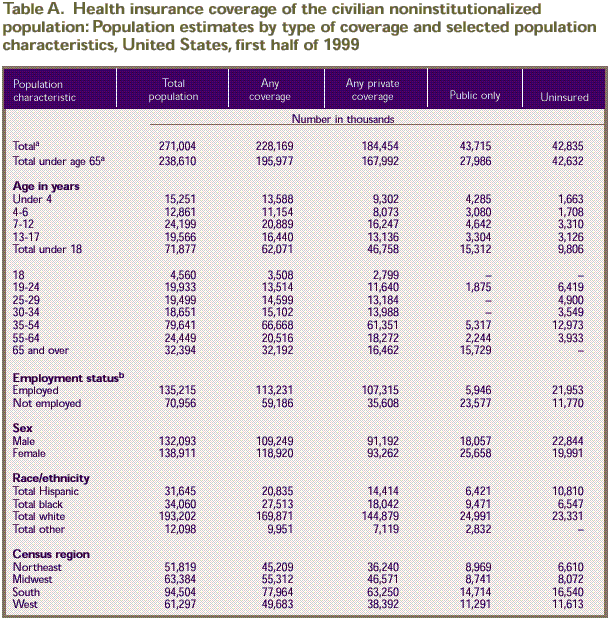
a Includes
persons with unknown employment status and marital status.
b For individuals age 16 and over.
- Sample
size too small to produce reliable estimates.
Source: Center
for Financing, Access, and Cost Trends, Agency for Healthcare
Research and Quality: Medical Expenditure Panel Survey Household
Component, 1999.
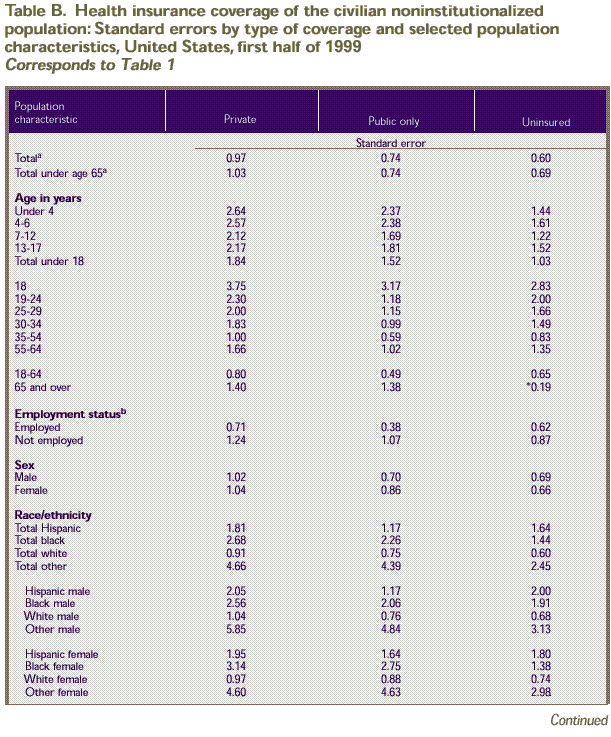
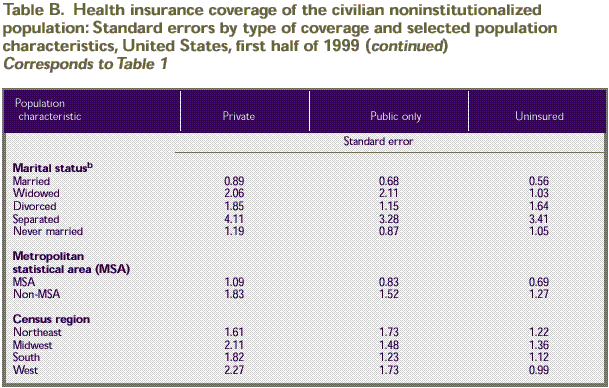
a Includes
persons with unknown employment status and marital status.
b For individuals age 16 and over.
* Relative standard error is greater than
or equal to 30 percent.
Source: Center for Financing, Access,
and Cost Trends, Agency for Healthcare Research and Quality:
Medical Expenditure Panel Survey Household Component, 1999.
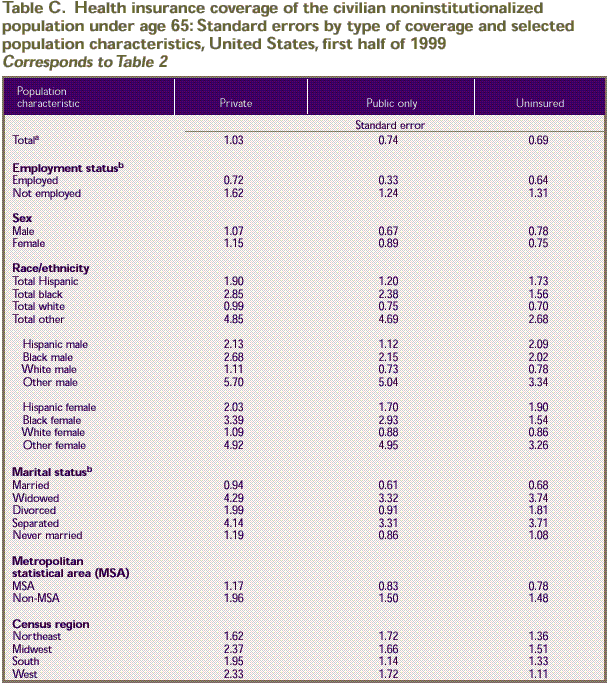
a Includes
persons with unknown employment status and marital status.
b For individuals age 16 and over.
Source: Center for Financing, Access,
and Cost Trends, Agency for Healthcare Research and Quality:
Medical Expenditure Panel Survey Household Component, 1999.

a Includes
persons with unknown perceived health status.
* Relative standard error is greater than
or equal to 30 percent.
Source: Center for Financing, Access,
and Cost Trends, Agency for Healthcare Research and Quality:
Medical Expenditure Panel Survey Household Component, 1999.
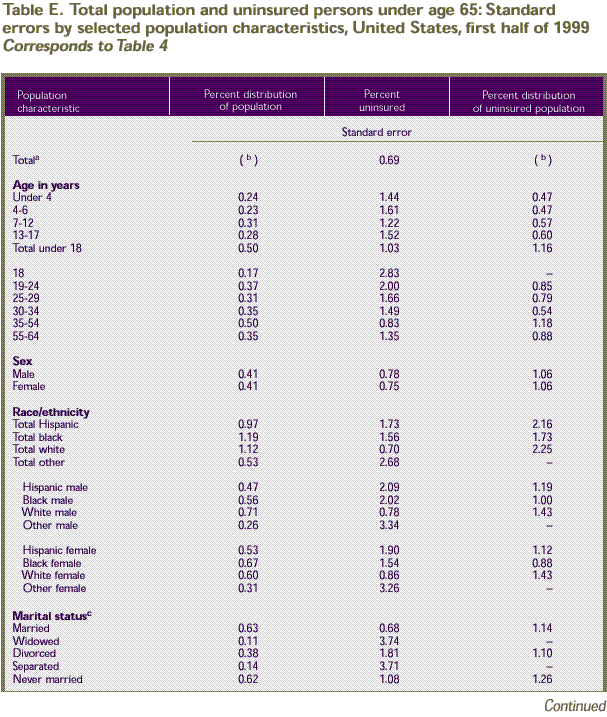

a Total
includes persons with unknown perceived health status and
marital status.
b Not applicable.
c For individuals age 16 and over.
- Sample
size too small to produce reliable estimates.
Source: Center
for Financing, Access, and Cost Trends, Agency for Healthcare
Research and Quality: Medical Expenditure Panel Survey Household
Component, 1999.
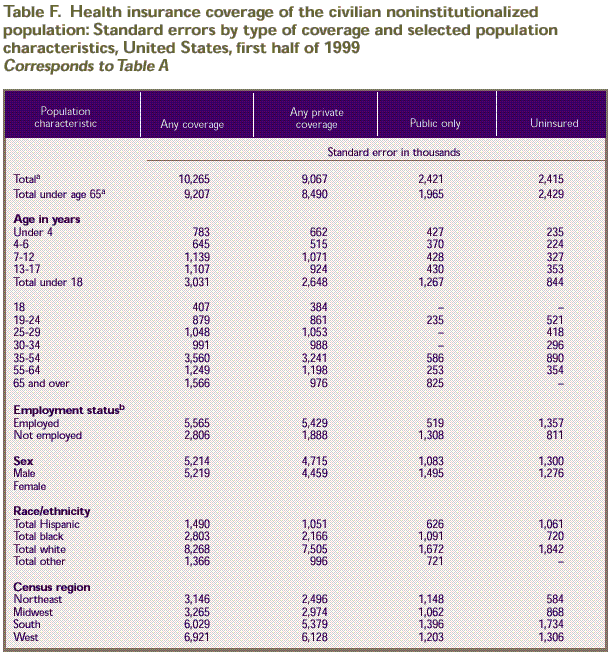
a Includes
persons with unknown employment status and marital status.
b For individuals age 16 and over.
- Sample
size too small to produce reliable estimates.
Source: Center
for Financing, Access, and Cost Trends, Agency for Healthcare
Research and Quality: Medical Expenditure Panel Survey Household
Component, 1999.
^top
Suggested
Citation:
Rhoades, J. A. and Chu, M. C. Research
Findings #14: Health Insurance Status of the Civilian Noninstitutionalized
Population: 1999. December 2000. Agency
for Healthcare Research and Quality, Rockville,
MD.
http://www.meps.ahrq.gov/data_files/publications/rf14/rf14.shtml |
| 